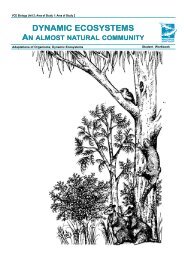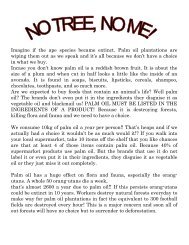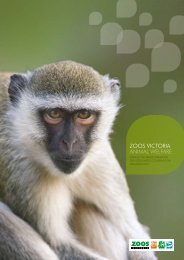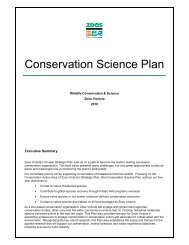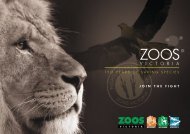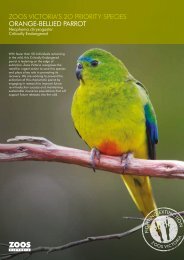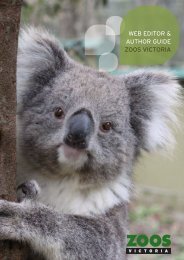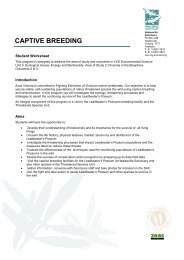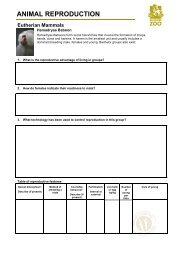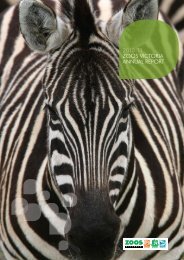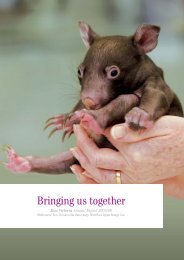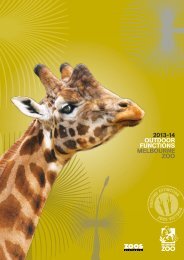Herbivores, Carnivores & Constrictor Jaws - Student ... - Zoos Victoria
Herbivores, Carnivores & Constrictor Jaws - Student ... - Zoos Victoria
Herbivores, Carnivores & Constrictor Jaws - Student ... - Zoos Victoria
You also want an ePaper? Increase the reach of your titles
YUMPU automatically turns print PDFs into web optimized ePapers that Google loves.
<strong>Herbivores</strong>, <strong>Carnivores</strong> &<br />
<strong>Constrictor</strong> <strong>Jaws</strong> - <strong>Student</strong> Trail<br />
VCE Biology Unit 1:<br />
Area of Study 2:<br />
Unity and Diversity<br />
Functioning Organisms<br />
Werribee<br />
Open Range Zoo<br />
PO Box 460<br />
Werribee<br />
<strong>Victoria</strong> 3030<br />
Australia<br />
T 61 3 9731 9601<br />
F 61 3 9731 9644<br />
zoo.org.au/learning<br />
Introduction<br />
<strong>Herbivores</strong>, <strong>Carnivores</strong> and <strong>Constrictor</strong> <strong>Jaws</strong> is designed to meet the requirements of the Schoolassessed<br />
Coursework (SAC) component for Outcome 2 (practical activity). It addresses the key<br />
knowledge and skills related to VCE Biology Unit One, with particular emphasis on the diet, dentition<br />
and digestion of animals.<br />
Aims<br />
This program aims to:<br />
• investigate the common requirements of herbivores, omnivores and carnivores<br />
• examine the relationship between diet, dentition, hunting/foraging behaviour, body structure<br />
and habitat<br />
• observe, identify and describe the adaptations in specific animals for obtaining and processing<br />
nutrients and removing wastes<br />
• compare and classify animals based on their diet and how they process nutrients<br />
• develop some of the skills required when investigating living organisms and in collecting,<br />
analysing and presenting data.<br />
Check out what you can do to Fight<br />
Extinction at Act Wild www.actwild.org.au<br />
<strong>Herbivores</strong>, <strong>Carnivores</strong> and <strong>Constrictor</strong> <strong>Jaws</strong> <strong>Student</strong> Trail 1
Discovery Session<br />
Skull Analysis<br />
1. By analysing skulls we can learn about an animal’s way of life.<br />
Observe the skulls provided and circle the most correct response in the table below:<br />
Table 1:<br />
Diet group:<br />
Dentition:<br />
Upper Incisors<br />
Upper Incisors<br />
Upper Incisors<br />
Lower Incisors<br />
Lower Incisors<br />
Lower Incisors<br />
Canines<br />
Canines<br />
Canines<br />
Molars<br />
Molars<br />
Molars<br />
Carnassial Teeth<br />
Carnassial Teeth<br />
Carnassial Teeth<br />
Mandible (lower jaw)<br />
length:<br />
Long<br />
Long<br />
Long<br />
Short<br />
Short<br />
Short<br />
Diastema:<br />
The gap between the<br />
incisors and molars.<br />
Present<br />
Absent<br />
Present<br />
Absent<br />
Present<br />
Absent<br />
Eye position:<br />
Forward Facing<br />
Forward Facing<br />
Forward Facing<br />
Side Facing<br />
Side Facing<br />
Side Facing<br />
Saggital crest:<br />
A ridge extending<br />
along the skull. It is a<br />
site for muscle<br />
attachment.<br />
Zygomatic Arch:<br />
The arch of bone<br />
beneath the eye<br />
sometimes referred to<br />
as the “cheek” bone.<br />
Name of Animal:<br />
Present<br />
Absent<br />
Wide<br />
Narrow<br />
Present<br />
Absent<br />
Wide<br />
Narrow<br />
Present<br />
Absent<br />
Wide<br />
Narrow<br />
Rodent Skull<br />
incisors<br />
diastema<br />
zygomatic arch<br />
mandible<br />
molars<br />
<strong>Herbivores</strong>, <strong>Carnivores</strong> and <strong>Constrictor</strong> <strong>Jaws</strong> <strong>Student</strong> Trail 2
2. After completing the skull analysis in Q1.explain how we can determine an animal’s diet by<br />
examining the structure of its skull and teeth.<br />
Scats<br />
3. Observe the scats provided.<br />
a. Draw and describe the scats of different animals in Table 2 below.<br />
Table 2:<br />
Observations, e.g. size, particles present<br />
Dietary group, e.g.<br />
carnivore, herbivore,<br />
ruminant, etc.<br />
Herbivore<br />
Ruminant<br />
Giraffe<br />
Herbivore<br />
Non-ruminant<br />
Zebra<br />
b. What can you learn about animals by looking at their scats?<br />
<strong>Herbivores</strong>, <strong>Carnivores</strong> and <strong>Constrictor</strong> <strong>Jaws</strong> <strong>Student</strong> Trail 3
Safari Tour<br />
The Escarpment: Broad Observations<br />
4. Select a herd of animals for observation.<br />
a. How many individuals are in the group?<br />
b. Estimate how many of these individuals are feeding at the one time.<br />
To complete questions 5-15 you are required to select an individual animal to observe which is<br />
grazing within a group.<br />
Feeding<br />
5. Describe how the grass is cropped by the animal (where possible, describe the action of the<br />
jaw, lips, tongue and teeth).<br />
6. Explain how the head structure of the animal you are observing is suited to an herbivorous diet.<br />
<strong>Herbivores</strong>, <strong>Carnivores</strong> and <strong>Constrictor</strong> <strong>Jaws</strong> <strong>Student</strong> Trail 4
Body Structure<br />
7. Draw a rough sketch showing the body proportions of your selected animal.<br />
8. How does the size of the abdomen of the animal you have selected to observe compare with<br />
other animals you have seen today?<br />
9. After listening to your guide and making your own observations describe how the body<br />
proportions of young animals differ from those of older animals.<br />
10. Suggest for what purpose the animal’s tail is used.<br />
11. How many toes does the animal have on each foot?<br />
12. Is this animal a ruminant or non-ruminant? Provide a reason to support your answer.<br />
<strong>Herbivores</strong>, <strong>Carnivores</strong> and <strong>Constrictor</strong> <strong>Jaws</strong> <strong>Student</strong> Trail 5
13. Draw a profile of the head of the animal you have been observing, marking in mouth,<br />
eye and ear positions.<br />
14. Suggest how the relative positions of the mouth, eyes and ears may help the animal to avoid<br />
predation.<br />
15. Which other structural and behavioural features does the animal have to help it avoid<br />
predation?<br />
African Walking Trail (self guided)<br />
Lion (Panthera leo)<br />
16. How do lions detect their prey?<br />
17. Spend a few minutes observing the lions. Describe their behaviour.<br />
<strong>Herbivores</strong>, <strong>Carnivores</strong> and <strong>Constrictor</strong> <strong>Jaws</strong> <strong>Student</strong> Trail 6
18. Suggest a hypothesis to explain why lions spend so much time being inactive.<br />
Cheetah (Acinonyx jubatus)<br />
19. Observe the Cheetah closely. On the diagram below label, with a brief description, the structural<br />
adaptations it has that would be considered an advantage for capturing prey.<br />
20. Once a Cheetah has made a kill, hyenas and lions move in very quickly to take over the food.<br />
Suggest some strategies the Cheetah may use to maximise the amount of meat it consumes<br />
before it is taken over by a scavenger:<br />
21. Zebras may spend up to 60% of their day grazing on food, while Cheetahs may not eat anything<br />
all day. Explain why there is such a large difference between the amount of time these animals<br />
spend eating.<br />
<strong>Herbivores</strong>, <strong>Carnivores</strong> and <strong>Constrictor</strong> <strong>Jaws</strong> <strong>Student</strong> Trail 7
Meerkat (Suricata suricatta)<br />
The diet of the Meerkat consists of buried invertebrates such as beetle larvae, crickets, scorpions;<br />
and small vertebrates such as snakes, birds and mice. Its water requirements are obtained by<br />
eating melons, roots and tubers.<br />
22. Spend some time observing the Meerkats. On the diagram below label, with a brief description,<br />
the structural adaptations that may enable the Meerkat to find and capture prey.<br />
23. The main predators of the Meerkat are hawks and eagles. How does their behaviour help them to<br />
avoid being preyed upon by these animals?<br />
Conclusions<br />
24. Compare ruminants and non ruminants by completing the table below:<br />
Table 3:<br />
Comparative amounts Ruminants Non ruminants<br />
Time spent eating: high / low high / low<br />
Nutrition derived from high / low<br />
high / low<br />
herbage eaten:<br />
Time take to digest herbage: large / small large / small<br />
Quality of herbage digested: high / low high / low<br />
Location of microbes in foregut / hindgut<br />
foregut / hindgut<br />
digestive system needed to<br />
break down cellulose:<br />
Consumption of water: high / low high / low<br />
Cud chewing: present / absent present / absent<br />
Examples: bison / giraffe / rhinoceros /<br />
deer /antelope / zebra / camel<br />
/ hippopotamus<br />
bison / giraffe / rhinoceros /<br />
deer /antelope / zebra / camel<br />
/ hippopotamus<br />
<strong>Herbivores</strong>, <strong>Carnivores</strong> and <strong>Constrictor</strong> <strong>Jaws</strong> <strong>Student</strong> Trail 8
25a. The skulls and digestive systems below are representative of a carnivore, omnivore<br />
and two types of herbivore; ruminant and non-ruminant. Draw a line to match the skulls<br />
with the digestive systems.<br />
Skull<br />
Digestive System<br />
A<br />
1<br />
B<br />
2<br />
C<br />
3<br />
D<br />
4<br />
25b. The skulls and digestive systems above belong to the zebra, giraffe, chimpanzee and cheetah.<br />
Label the skulls and digestive systems you have matched together with each of these animal names.<br />
Give reasons for your choices.<br />
Cheetah.<br />
Zebra.<br />
Chimpanzee.<br />
Giraffe.<br />
<strong>Herbivores</strong>, <strong>Carnivores</strong> and <strong>Constrictor</strong> <strong>Jaws</strong> <strong>Student</strong> Trail 9
26. Identify and describe the role of the different kinds of vertebrate teeth.<br />
27. Use specific examples to compare the digestive systems of :<br />
a. Ruminant and non ruminant<br />
b. Herbivore and carnivore.<br />
28. Refer to two selected examples you observed today to explain how structural adaptations related<br />
to acquiring and processing food assist an animal’s chances of survival. Include one example of<br />
an herbivore and one example of a carnivore.<br />
<strong>Herbivores</strong>, <strong>Carnivores</strong> and <strong>Constrictor</strong> <strong>Jaws</strong> <strong>Student</strong> Trail 10
Conservation Action - Beads for Wildlife (Additional activity)<br />
29. What impact would the introduction of domestic animals (such as Cattle and Goats) have on the<br />
wild populations of Zebras and Lions of the Melako Conservancy in Northern Kenya?<br />
30. Rank the following animals from 1 to 10 in order of importance to the Maasai people of Melako.<br />
Your ranking should consider 1 being the most important to 10 the least important. Suggest why<br />
___<br />
Elephant ____________________________________________________________<br />
___ Lion _____________________________________________________________<br />
___<br />
___<br />
Zebra _____________________________________________________________<br />
Rabbit _____________________________________________________________<br />
___ Bee _____________________________________________________________<br />
___ Cow _____________________________________________________________<br />
___<br />
___<br />
___<br />
___<br />
Baboon _____________________________________________________________<br />
Chicken _____________________________________________________________<br />
Giraffe _____________________________________________________________<br />
Camel _____________________________________________________________<br />
31. How can African Bead work help preserve the Endangered Grevy’s Zebra of Melako?<br />
32. What can you do to help <strong>Zoos</strong> <strong>Victoria</strong> and Grevy’s Zebra?<br />
<strong>Herbivores</strong>, <strong>Carnivores</strong> and <strong>Constrictor</strong> <strong>Jaws</strong> <strong>Student</strong> Trail 11
Glossary<br />
Adaptation:<br />
Canines:<br />
Carnassial teeth:<br />
Carnivore:<br />
Dentition:<br />
Herbivore:<br />
Incisor:<br />
Molar:<br />
Non-ruminant:<br />
Omnivore:<br />
Pre-molars:<br />
Ruminant:<br />
Scat:<br />
Ungulate:<br />
A feature that an organism has to help it to survive, it may be structural,<br />
behavioural or physiological.<br />
The pointed conical teeth located between the incisors and the first molars.<br />
Molars that are modified to have sharp edges for cutting flesh. Found in<br />
carnivores.<br />
An animal that eats meat.<br />
The type, number, and arrangement of a set of teeth.<br />
An animal that eats plants.<br />
A tooth adapted for cutting or gnawing, located at the front of the mouth.<br />
A tooth with a broad crown used to grind food.<br />
Odd toed ungulates of the Order Perissodactyla. One chamber stomach.<br />
Includes horses, zebras and rhinoceros.<br />
An animal that eats both meat and plants.<br />
The teeth that occur on either side of the upper and lower jaw, behind the<br />
canines(in the case off carnivores) or in front of the incisors and in front of the<br />
molars.<br />
Even toed ungulates of the Order Artiodactyla. The stomach is divided into<br />
four components. Partially digested food is regurgitated and chewed again<br />
(chewing the cud). Includes cattle, deer, antelope, giraffe.<br />
Faeces.<br />
A hoofed animal.<br />
Resources<br />
Evans, B. Ladiges, P., McKenzie, J. and Sanders, Y. (2005). Heinemann Biology One. 4 th Ed.<br />
Harcourt Education Press.<br />
Kinnear, J., Martin, M. (2005). Nature of Biology Book One. 3 rd Ed. Jacaranda Press<br />
Semple, A., et.al. (2005). Biology. 2 nd Ed. Nelson Press.<br />
Diet and reproduction of <strong>Victoria</strong>n mammals<br />
http://flyaqis.mov.vic.gov.au/cgi-bin/texhtml?form=bio_mammalx<br />
What is an ungulate?<br />
http://www.zoo.nsw.gov.au/content/view.asp?id=1039<br />
Ruminant Digestion<br />
www.mun.ca/biology/scarr/Ruminant_Digestion.html<br />
General anatomy of the ruminant digestive system<br />
www.edis.ifas.ufl.edu/BODY_DS061<br />
Sheep ruminant digestion<br />
www.sheep101.info/cud.html<br />
A comparative anatomy of eating<br />
www.ecologos.org/anatomy.htm<br />
<strong>Herbivores</strong>, <strong>Carnivores</strong> and <strong>Constrictor</strong> <strong>Jaws</strong> <strong>Student</strong> Trail 12




